Professional Burnout: A Comprehensive Analysis of Theory and Research
VerifiedAdded on 2022/01/08
|47
|28316
|20
Report
AI Summary
This document is a comprehensive exploration of professional burnout, drawing from the book "Professional Burnout: Recent Developments in Theory and Research." The content delves into the historical and conceptual development of burnout, tracing its evolution from a social problem to a scholarly construct. It examines various theoretical perspectives, including interpersonal, individual, and organizational approaches, and explores the multidimensional nature of burnout. The report covers measurement methodologies, cross-national perspectives, and the future of burnout research. The document also provides a review of the historical development of the burnout concept. The book explores different models and theories of burnout, including the Maslach Burnout Inventory, and considers factors such as social comparison, existential perspectives, and organizational structures in relation to burnout. It also explores the impact of burnout on creativity, health, and organizational healthiness, along with methodological issues and future directions in burnout research.
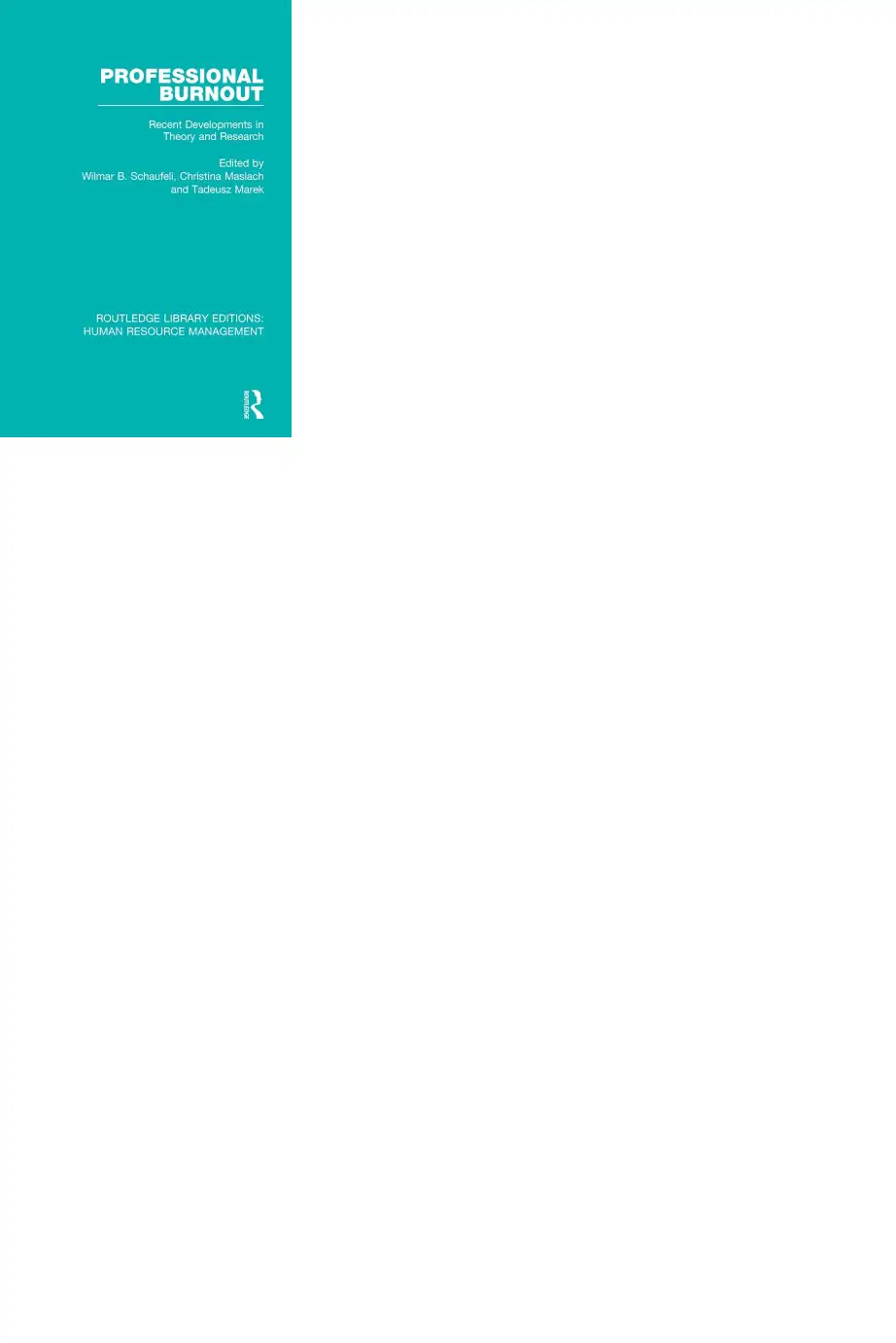
Paraphrase This Document
Need a fresh take? Get an instant paraphrase of this document with our AI Paraphraser
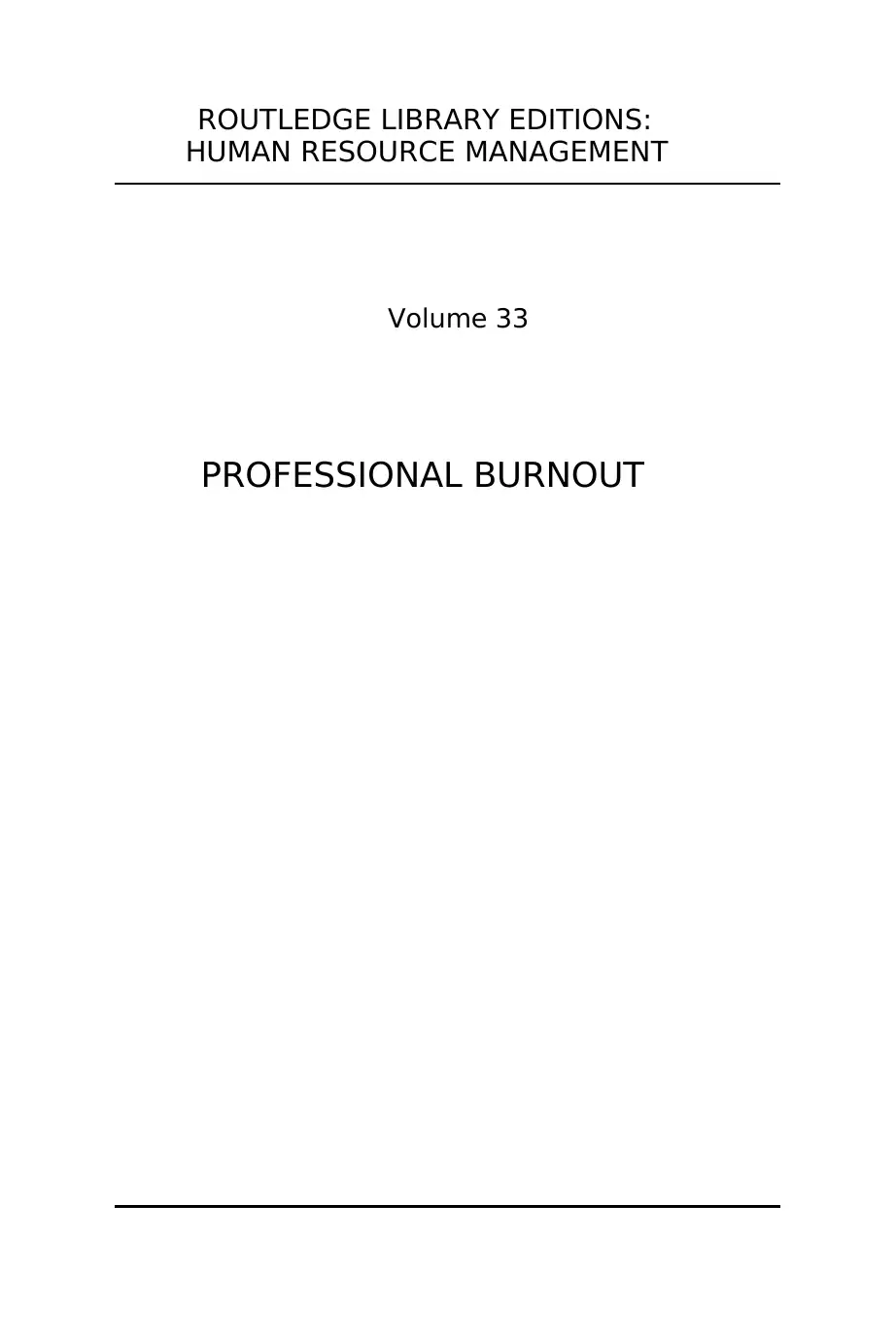
ROUTLEDGE LIBRARY EDITIONS:
HUMAN RESOURCE MANAGEMENT
Volume 33
PROFESSIONAL BURNOUT
HUMAN RESOURCE MANAGEMENT
Volume 33
PROFESSIONAL BURNOUT

⊘ This is a preview!⊘
Do you want full access?
Subscribe today to unlock all pages.

Trusted by 1+ million students worldwide
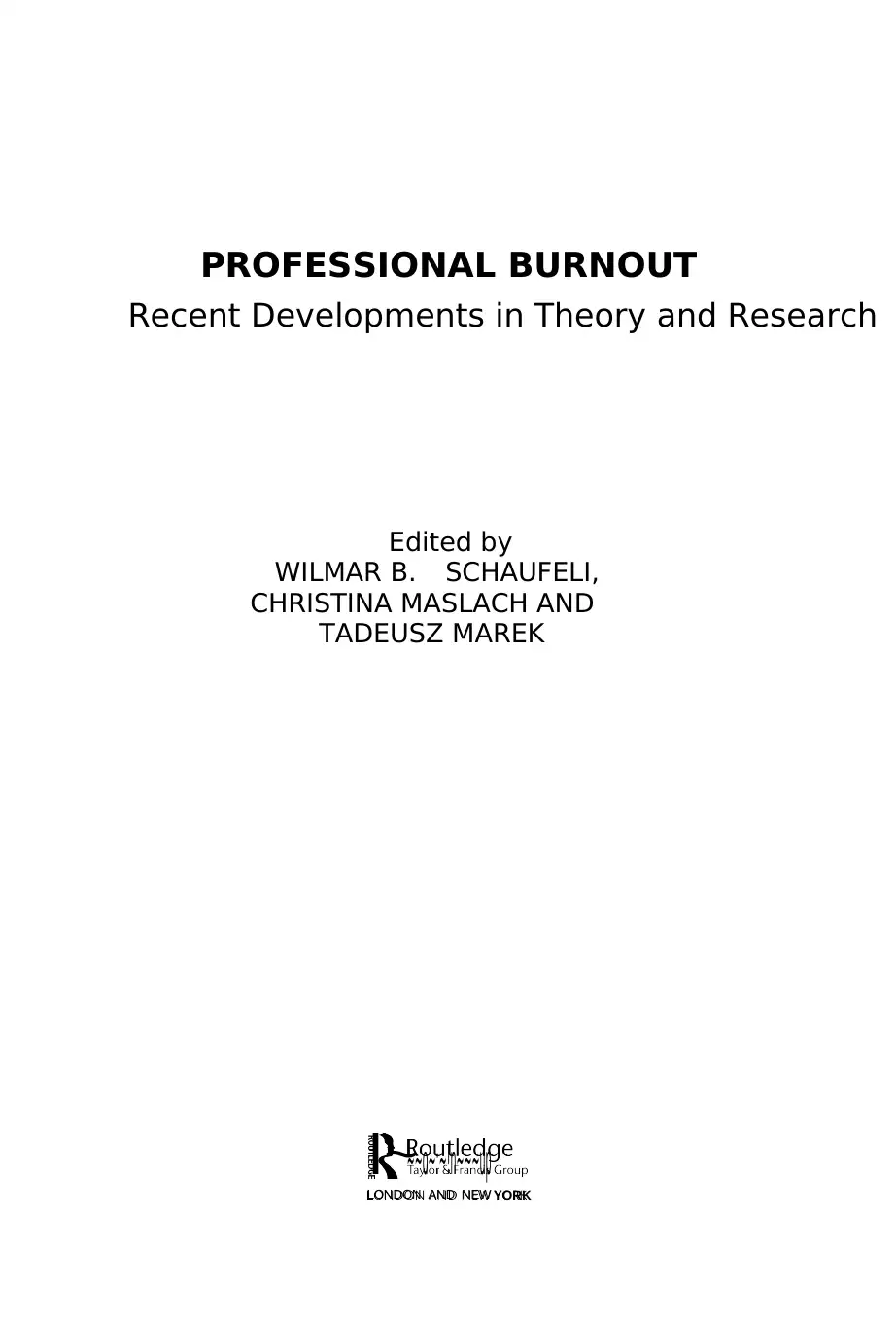
PROFESSIONAL BURNOUT
Recent Developments in Theory and Research
Edited by
WILMAR B. SCHAUFELI,
CHRISTINA MASLACH AND
TADEUSZ MAREK
I~~~o~:~!n~~~up
LONDON AND NEW YORK
Recent Developments in Theory and Research
Edited by
WILMAR B. SCHAUFELI,
CHRISTINA MASLACH AND
TADEUSZ MAREK
I~~~o~:~!n~~~up
LONDON AND NEW YORK
Paraphrase This Document
Need a fresh take? Get an instant paraphrase of this document with our AI Paraphraser
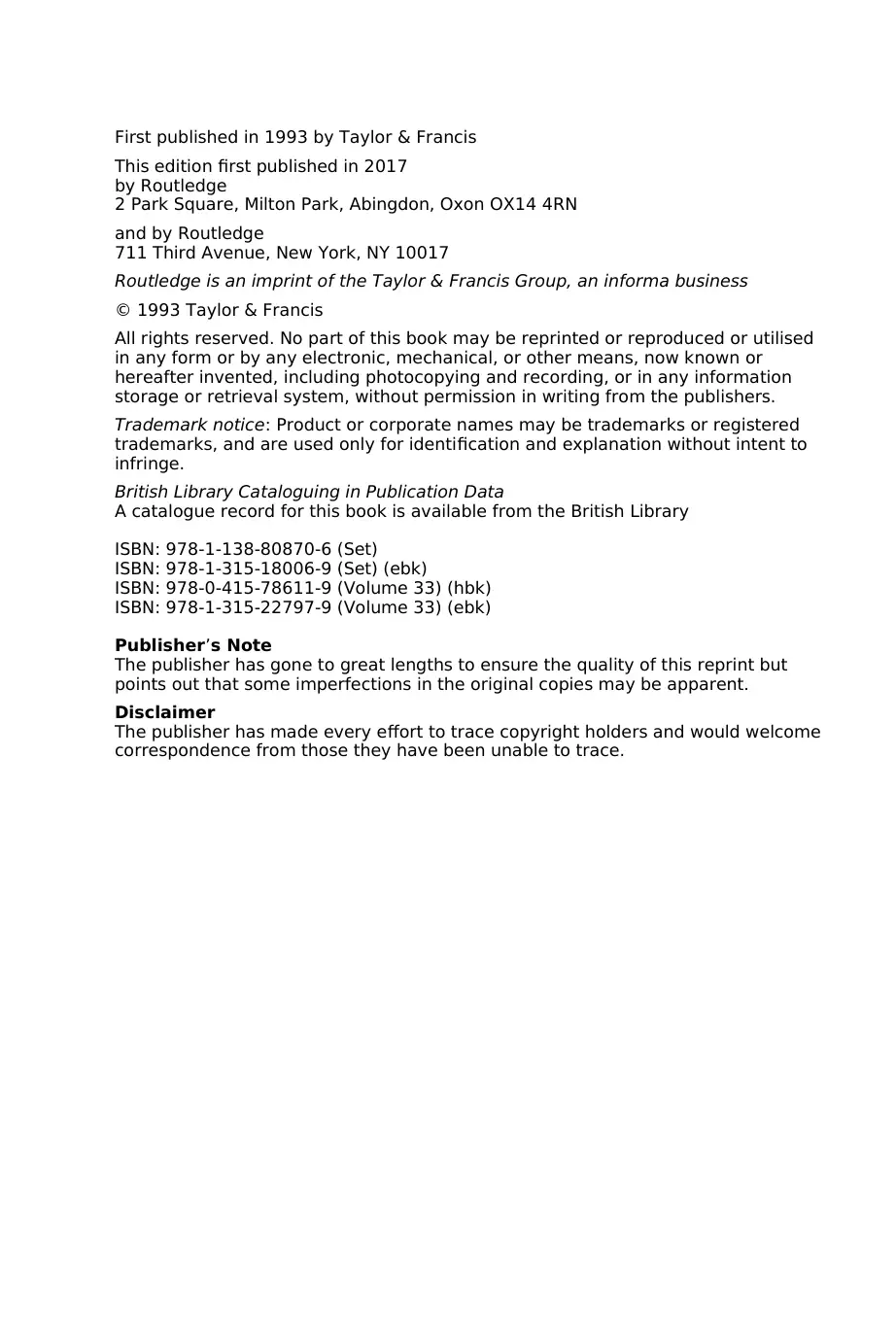
First published in 1993 by Taylor & Francis
This edition first published in 2017
by Routledge
2 Park Square, Milton Park, Abingdon, Oxon OX14 4RN
and by Routledge
711 Third Avenue, New York, NY 10017
Routledge is an imprint of the Taylor & Francis Group, an informa business
© 1993 Taylor & Francis
All rights reserved. No part of this book may be reprinted or reproduced or utilised
in any form or by any electronic, mechanical, or other means, now known or
hereafter invented, including photocopying and recording, or in any information
storage or retrieval system, without permission in writing from the publishers.
Trademark notice: Product or corporate names may be trademarks or registered
trademarks, and are used only for identification and explanation without intent to
infringe.
British Library Cataloguing in Publication Data
A catalogue record for this book is available from the British Library
ISBN: 978-1-138-80870-6 (Set)
ISBN: 978-1-315-18006-9 (Set) (ebk)
ISBN: 978-0-415-78611-9 (Volume 33) (hbk)
ISBN: 978-1-315-22797-9 (Volume 33) (ebk)
Publisher’s Note
The publisher has gone to great lengths to ensure the quality of this reprint but
points out that some imperfections in the original copies may be apparent.
Disclaimer
The publisher has made every effort to trace copyright holders and would welcome
correspondence from those they have been unable to trace.
This edition first published in 2017
by Routledge
2 Park Square, Milton Park, Abingdon, Oxon OX14 4RN
and by Routledge
711 Third Avenue, New York, NY 10017
Routledge is an imprint of the Taylor & Francis Group, an informa business
© 1993 Taylor & Francis
All rights reserved. No part of this book may be reprinted or reproduced or utilised
in any form or by any electronic, mechanical, or other means, now known or
hereafter invented, including photocopying and recording, or in any information
storage or retrieval system, without permission in writing from the publishers.
Trademark notice: Product or corporate names may be trademarks or registered
trademarks, and are used only for identification and explanation without intent to
infringe.
British Library Cataloguing in Publication Data
A catalogue record for this book is available from the British Library
ISBN: 978-1-138-80870-6 (Set)
ISBN: 978-1-315-18006-9 (Set) (ebk)
ISBN: 978-0-415-78611-9 (Volume 33) (hbk)
ISBN: 978-1-315-22797-9 (Volume 33) (ebk)
Publisher’s Note
The publisher has gone to great lengths to ensure the quality of this reprint but
points out that some imperfections in the original copies may be apparent.
Disclaimer
The publisher has made every effort to trace copyright holders and would welcome
correspondence from those they have been unable to trace.
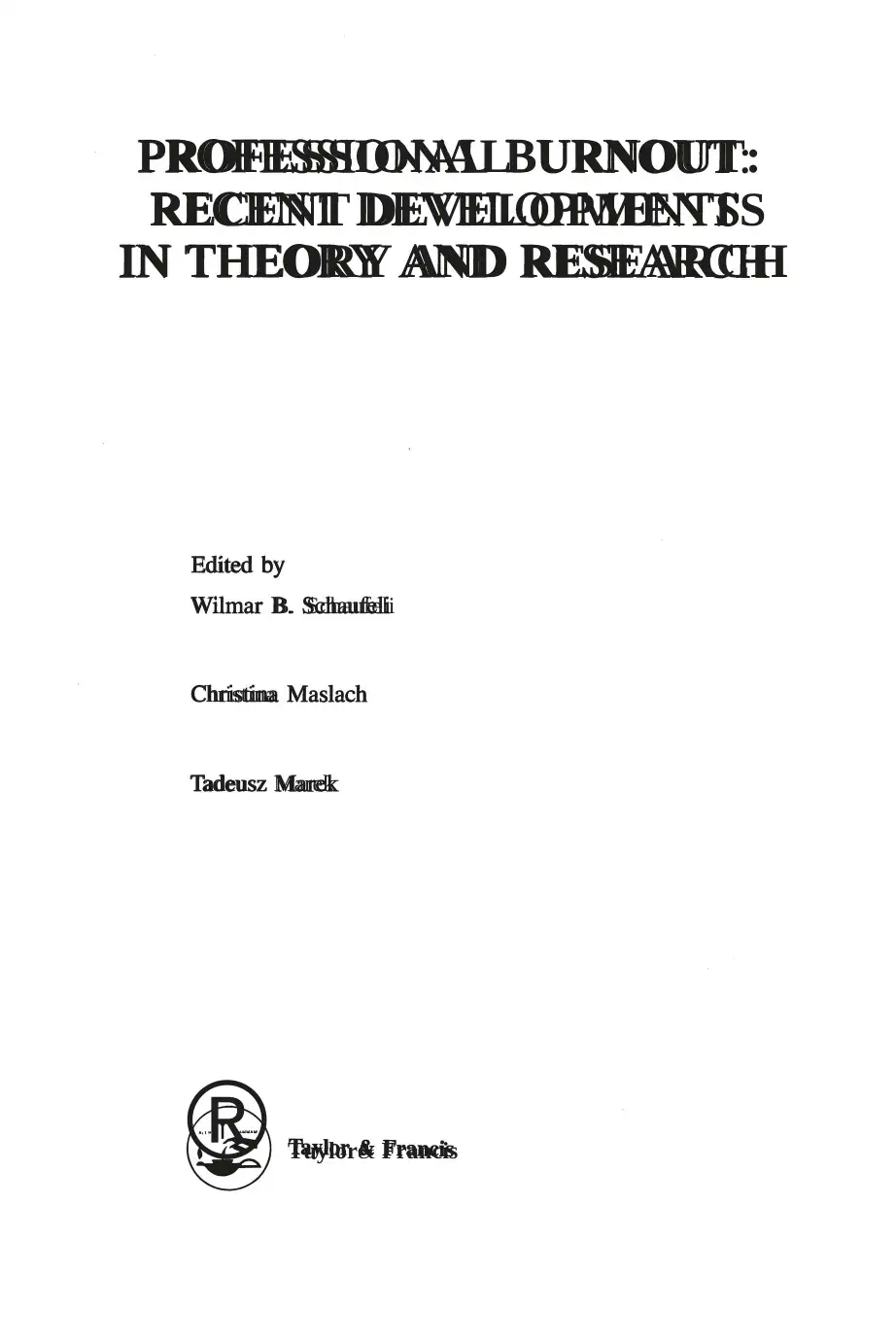
PROFESSIONALBURNOUT:
RECENT DEVELOPMENTS
IN THEORY AND RESEARCH
Edited by
Wilmar B. Schaufeli
Christina Maslach
Tadeusz Marek
® Tuylor& Francis
RECENT DEVELOPMENTS
IN THEORY AND RESEARCH
Edited by
Wilmar B. Schaufeli
Christina Maslach
Tadeusz Marek
® Tuylor& Francis
⊘ This is a preview!⊘
Do you want full access?
Subscribe today to unlock all pages.

Trusted by 1+ million students worldwide
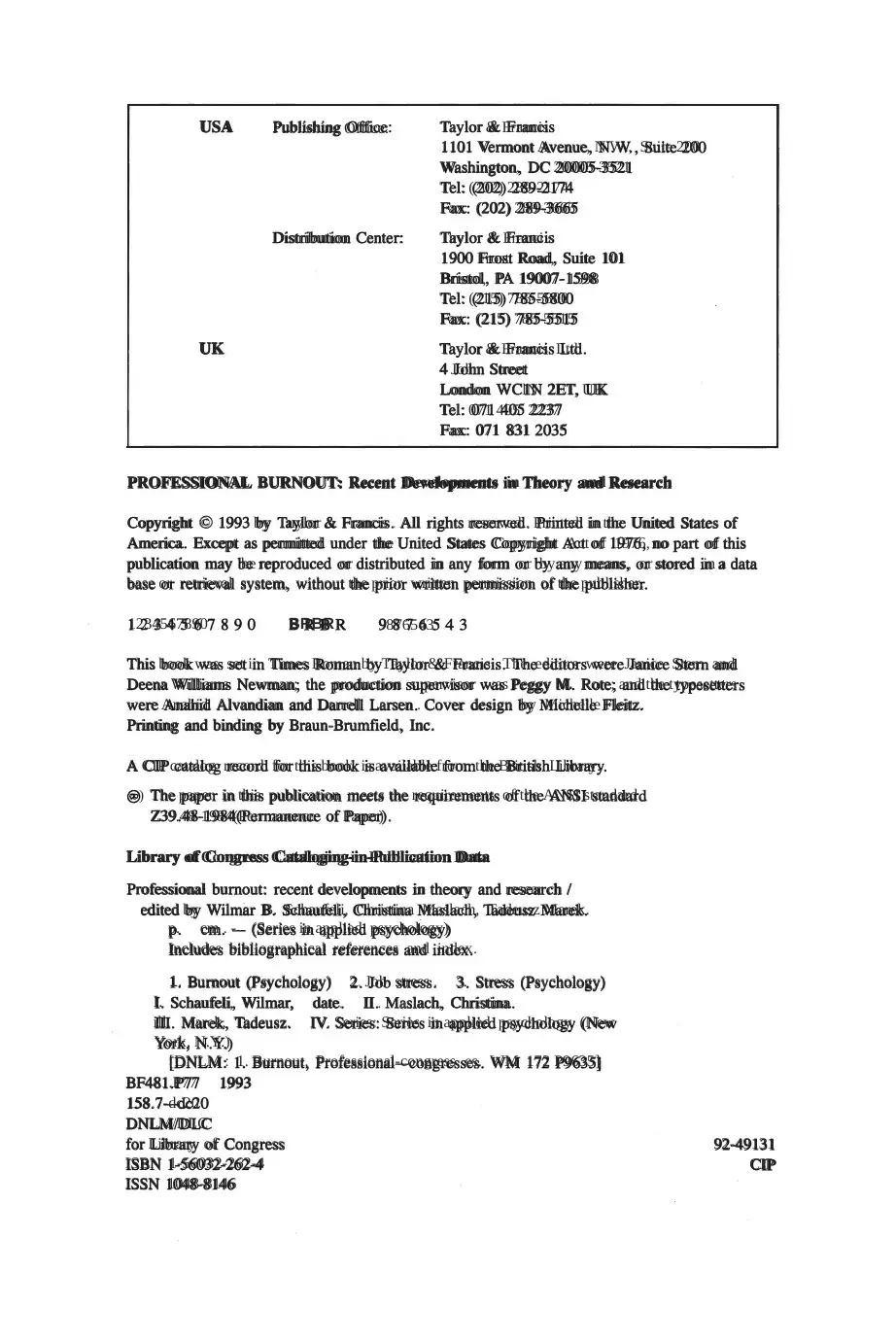
USA Publishing Office:
Distribution Center:
UK
Taylor & Francis
1101 Vermont Avenue, N.W., Suite 200
Washington, DC 20005-3521
Tel: (202) 289-2174
Fax: (202) 289-3665
Tuylor & Franci s
1900 Frost Road, Suite 101
Bristol, PA 19007- 1598
Tel: (215) 785-5800
Fax: (215) 785-5515
Taylor & Francis Ltd.
4 John Street
London WClN 2ET, UK
Tel: 071 405 2237
Fax: 071 831 2035
PROFESSIONAL BURNOUT: Recent Developments in Theory and Research
Copyright © 1993 by Tuylor & Francis . All rights reserved . Printed in the United States of
America. Except as permitted under the United States Copyright Act of 1976, no part of this
publication may be reproduced or distributed in any form or by any means, or stored in a data
base or retrieval system, without the prior written permission of the publisher.
1234567890 BRBR 9876543
This book was set in Times Roman by Taylor & Francis . The editors were Janice Stem and
Deena Williams Newman; the production supervisor was Peggy M. Rote; and the typesetters
were Anahid Alvandian and Darrell Larsen . Cover design by Michelle Fleitz.
Printing and binding by Braun-Brumfield, Inc.
A CIP catalog record for this book is available from the British Library.
@) The paper in this publication meets the requirements of the ANSI standard
Z39.48-1984(Permanence of Paper) .
Library of Congress Cataloging-in-Publication Data
Professional burnout: recent developments in theory and resear ch /
edited by Wilmar B. Schaufeli, Christina Maslach, Tadeusz Marek.
p. cm . - (Series in applied psychology)
Includes bibliographical references and index.
1. Burnout (Psychology) 2. Job stress . 3. Stress (Psychology)
I. Schaufeli, Wilmar, date. II . Maslach, Christina.
ill. Marek, Tadeusz. IV. Series: Series in applied psychology (New
York, N.Y.)
[DNLM : 1. Burnout, Professional-congress es. WM 172 P9635]
BF481.P77 1993
158.7-dc20
DNLM/DLC
for Library of Congress
ISBN 1-56032-262-4
ISSN 1048-8146
92-49131
CIP
Distribution Center:
UK
Taylor & Francis
1101 Vermont Avenue, N.W., Suite 200
Washington, DC 20005-3521
Tel: (202) 289-2174
Fax: (202) 289-3665
Tuylor & Franci s
1900 Frost Road, Suite 101
Bristol, PA 19007- 1598
Tel: (215) 785-5800
Fax: (215) 785-5515
Taylor & Francis Ltd.
4 John Street
London WClN 2ET, UK
Tel: 071 405 2237
Fax: 071 831 2035
PROFESSIONAL BURNOUT: Recent Developments in Theory and Research
Copyright © 1993 by Tuylor & Francis . All rights reserved . Printed in the United States of
America. Except as permitted under the United States Copyright Act of 1976, no part of this
publication may be reproduced or distributed in any form or by any means, or stored in a data
base or retrieval system, without the prior written permission of the publisher.
1234567890 BRBR 9876543
This book was set in Times Roman by Taylor & Francis . The editors were Janice Stem and
Deena Williams Newman; the production supervisor was Peggy M. Rote; and the typesetters
were Anahid Alvandian and Darrell Larsen . Cover design by Michelle Fleitz.
Printing and binding by Braun-Brumfield, Inc.
A CIP catalog record for this book is available from the British Library.
@) The paper in this publication meets the requirements of the ANSI standard
Z39.48-1984(Permanence of Paper) .
Library of Congress Cataloging-in-Publication Data
Professional burnout: recent developments in theory and resear ch /
edited by Wilmar B. Schaufeli, Christina Maslach, Tadeusz Marek.
p. cm . - (Series in applied psychology)
Includes bibliographical references and index.
1. Burnout (Psychology) 2. Job stress . 3. Stress (Psychology)
I. Schaufeli, Wilmar, date. II . Maslach, Christina.
ill. Marek, Tadeusz. IV. Series: Series in applied psychology (New
York, N.Y.)
[DNLM : 1. Burnout, Professional-congress es. WM 172 P9635]
BF481.P77 1993
158.7-dc20
DNLM/DLC
for Library of Congress
ISBN 1-56032-262-4
ISSN 1048-8146
92-49131
CIP
Paraphrase This Document
Need a fresh take? Get an instant paraphrase of this document with our AI Paraphraser
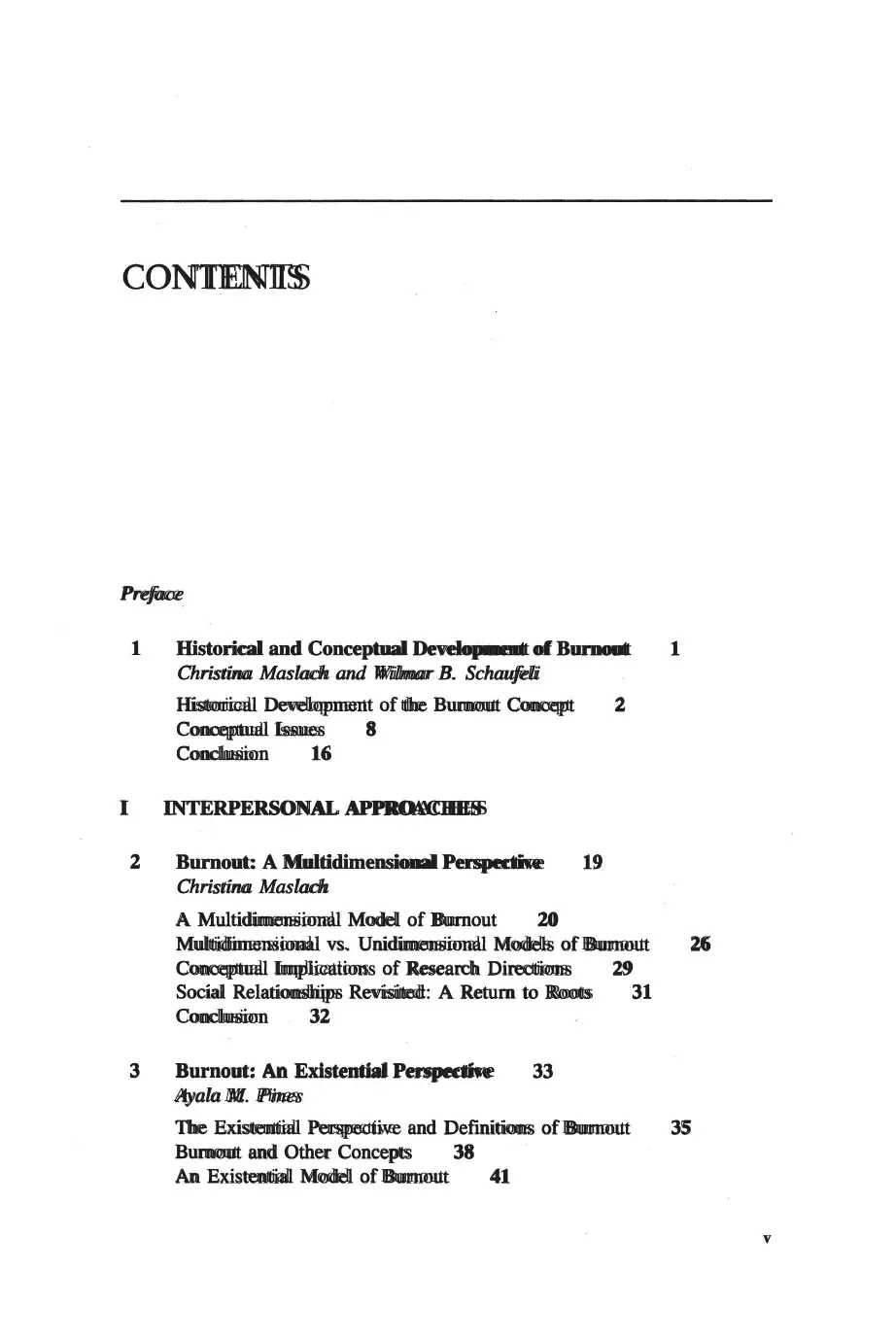
CONTENTS
Preface
1 Historical and Conceptual Development of Burnout
Christina Maslach and Wilmar B. Schaufeli
Historical Development of the Burnout Concept 2
Conceptual Issues 8
Conclusion 16
I INTERPERSONAL APPROACHES
2 Burnout: A Multidimensional Perspective
Christina Maslach
A Multidimensional Model of Burnout 20
19
1
Multidimensional vs. Unidimensional Models of Burnout 26
3
Conceptual Implications of Research Directions 29
Social Relationships Revisited: A Return to Roots 31
Conclusion 32
Burnout: An Existential Perspective
Ayala M. Pines
33
The Existential Perspective and Definitions of Burnout 35
Burnout and Other Concepts 38
An Existential Model of Burnout 41
V
Preface
1 Historical and Conceptual Development of Burnout
Christina Maslach and Wilmar B. Schaufeli
Historical Development of the Burnout Concept 2
Conceptual Issues 8
Conclusion 16
I INTERPERSONAL APPROACHES
2 Burnout: A Multidimensional Perspective
Christina Maslach
A Multidimensional Model of Burnout 20
19
1
Multidimensional vs. Unidimensional Models of Burnout 26
3
Conceptual Implications of Research Directions 29
Social Relationships Revisited: A Return to Roots 31
Conclusion 32
Burnout: An Existential Perspective
Ayala M. Pines
33
The Existential Perspective and Definitions of Burnout 35
Burnout and Other Concepts 38
An Existential Model of Burnout 41
V
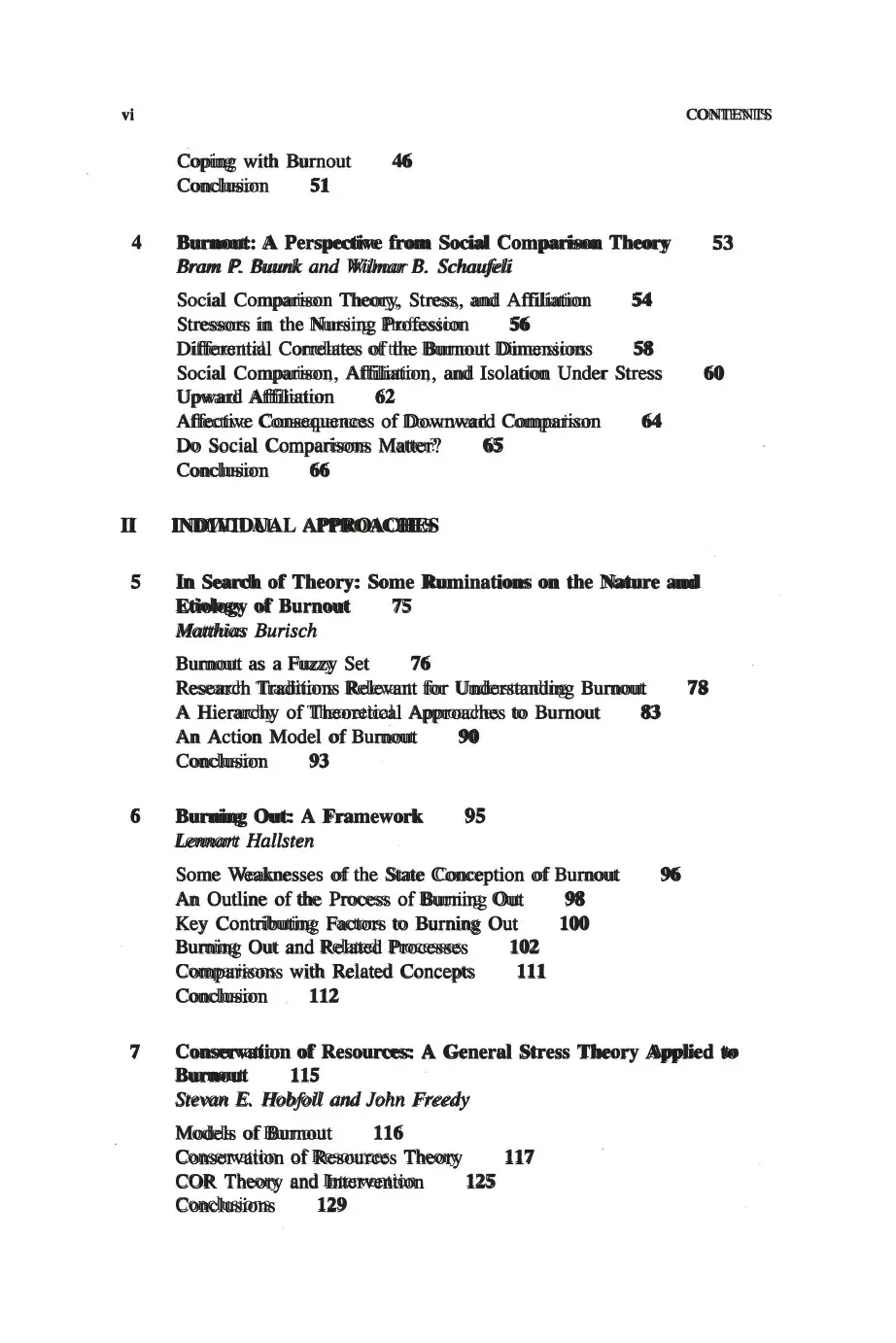
vi
4
Coping with Burnout 46
Conclusion 51
Burnout: A Perspective from Social Comparison Theory
Bram P. Buunk and Wilmar B. Schaufeli
Social Comparison Theory, Stress, and Affiliation 54
Stressors in the Nursing Profession 56
Differential Correlates of the Burnout Dimensions 58
CONTENTS
53
Social Comparison, Affiliation, and Isolation Under Stress 60
Upward Affiliation 62
Affective Consequences of Downward Comparison 64
Do Social Comparisons Matter? 65
Conclusion 66
II INDMDUAL APPROACHES
5 In Search of Theory: Some Ruminations on the Nature and
6
Etiology of Burnout 75
Matthias Burisch
Burnout as a Fuzzy Set 76
Research Traditions Relevant for Understanding Burnout 78
A Hierarchy of Theoretical Approaches to Burnout 83
An Action Model of Burnout 90
Conclusion 93
Burning Out: A Framework
Lennart Hallsten
95
Some Weaknesses of the State Conception of Burnout 96
An Outline of the Process of Burning Out 98
Key Contributing Factors to Burning Out 100
Burning Out and Related Processes 102
Comparisons with Related Concepts 111
Conclusion 112
7 Conservation of Resources: A General Stress Theory Applied to
Burnout 115
Stevan E. Hob/oil and John Freedy
Models of Burnout 116
Conservation of Resources Theory 117
COR Theory and Intervention 125
Conclusions 129
4
Coping with Burnout 46
Conclusion 51
Burnout: A Perspective from Social Comparison Theory
Bram P. Buunk and Wilmar B. Schaufeli
Social Comparison Theory, Stress, and Affiliation 54
Stressors in the Nursing Profession 56
Differential Correlates of the Burnout Dimensions 58
CONTENTS
53
Social Comparison, Affiliation, and Isolation Under Stress 60
Upward Affiliation 62
Affective Consequences of Downward Comparison 64
Do Social Comparisons Matter? 65
Conclusion 66
II INDMDUAL APPROACHES
5 In Search of Theory: Some Ruminations on the Nature and
6
Etiology of Burnout 75
Matthias Burisch
Burnout as a Fuzzy Set 76
Research Traditions Relevant for Understanding Burnout 78
A Hierarchy of Theoretical Approaches to Burnout 83
An Action Model of Burnout 90
Conclusion 93
Burning Out: A Framework
Lennart Hallsten
95
Some Weaknesses of the State Conception of Burnout 96
An Outline of the Process of Burning Out 98
Key Contributing Factors to Burning Out 100
Burning Out and Related Processes 102
Comparisons with Related Concepts 111
Conclusion 112
7 Conservation of Resources: A General Stress Theory Applied to
Burnout 115
Stevan E. Hob/oil and John Freedy
Models of Burnout 116
Conservation of Resources Theory 117
COR Theory and Intervention 125
Conclusions 129
⊘ This is a preview!⊘
Do you want full access?
Subscribe today to unlock all pages.

Trusted by 1+ million students worldwide
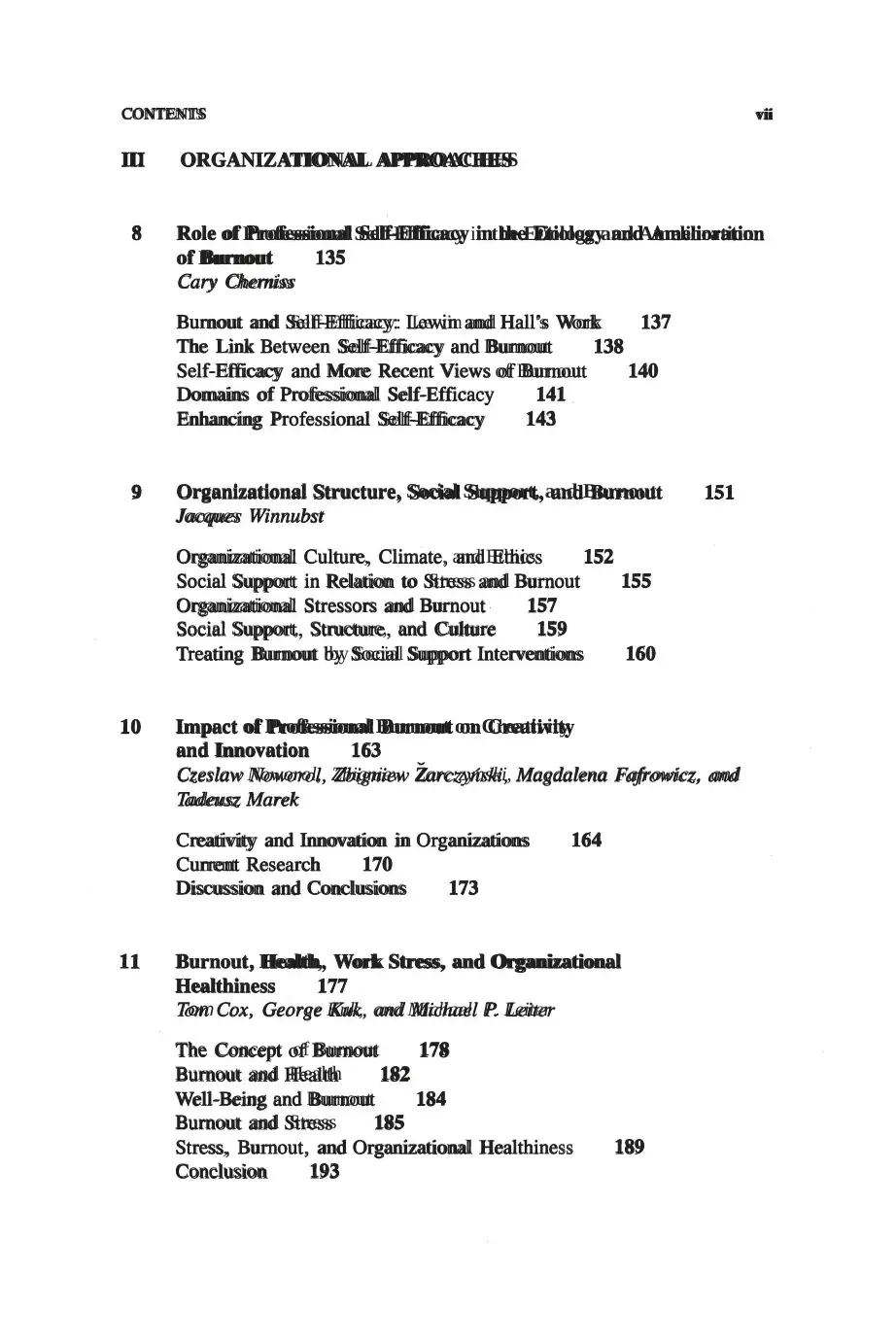
CONTENTS vii
ID ORGANIZATIONAL APPROACHES
8 Role of Professional Self-Efficacy in the Etiology and Amelioration
9
of Burnout 135
Cary Chemiss
Burnout and Self-Efficacy: Lewin and Hall's Work 137
The Link Between Self-Efficacy and Burnout 138
Self-Efficacy and More Recent Views of Burnout 140
Domains of Professional Self-Efficacy 141
Enhancing Professional Self-Efficacy 143
Organizational Structure, Social Support, and Burnout
Jacques Winnubst
Organizational Culture, Climate, and Ethics
Social Support in Relation to Stress and Burnout
Organizational Stressors and Burnout 157
Social Support, Structure, and Culture 159
Treating Burnout by Social Support Interventions
152
155
160
151
10 Impact of Professional Burnout on Creativity
and Innovation 163
Czeslaw Noworol, Zbigniew Zarc:zynski, Magdalena Fafrowicz, and
Tadeusz Marek
Creativity and Innovation in Organizations 164
Current Research 170
Discussion and Conclusions 173
11 Burnout, Health, Work Stress, and Organizational
Healthiness 177
Tom Cox, George Kuk, and Michael P. Leiter
The Concept of Burnout 178
Burnout and Health 182
Well-Being and Burnout 184
Burnout and Stress 185
Stress, Burnout, and Organizational Healthiness 189
Conclusion 193
ID ORGANIZATIONAL APPROACHES
8 Role of Professional Self-Efficacy in the Etiology and Amelioration
9
of Burnout 135
Cary Chemiss
Burnout and Self-Efficacy: Lewin and Hall's Work 137
The Link Between Self-Efficacy and Burnout 138
Self-Efficacy and More Recent Views of Burnout 140
Domains of Professional Self-Efficacy 141
Enhancing Professional Self-Efficacy 143
Organizational Structure, Social Support, and Burnout
Jacques Winnubst
Organizational Culture, Climate, and Ethics
Social Support in Relation to Stress and Burnout
Organizational Stressors and Burnout 157
Social Support, Structure, and Culture 159
Treating Burnout by Social Support Interventions
152
155
160
151
10 Impact of Professional Burnout on Creativity
and Innovation 163
Czeslaw Noworol, Zbigniew Zarc:zynski, Magdalena Fafrowicz, and
Tadeusz Marek
Creativity and Innovation in Organizations 164
Current Research 170
Discussion and Conclusions 173
11 Burnout, Health, Work Stress, and Organizational
Healthiness 177
Tom Cox, George Kuk, and Michael P. Leiter
The Concept of Burnout 178
Burnout and Health 182
Well-Being and Burnout 184
Burnout and Stress 185
Stress, Burnout, and Organizational Healthiness 189
Conclusion 193
Paraphrase This Document
Need a fresh take? Get an instant paraphrase of this document with our AI Paraphraser
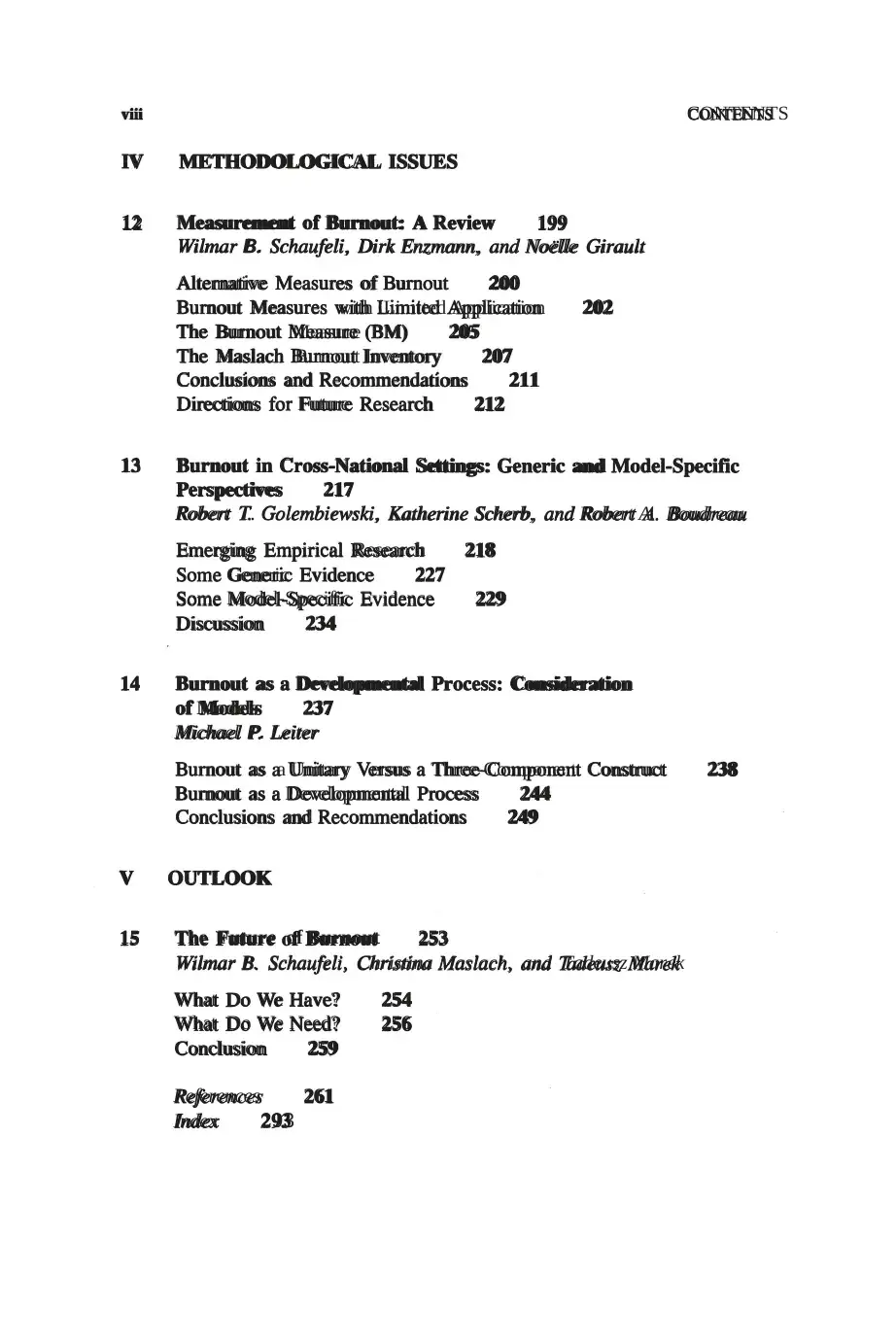
viii CONTENTS
IV METHODOLOGICAL ISSUES
12 Measurement of Burnout: A Review 199
Wilmar B. Schaufeli, Dirk Enzmann, and Noelle Girault
Alternative Measures of Burnout 200
Burnout Measures with Limited Application 202
The Burnout Measure (BM) 205
The Maslach Burnout Inventory 207
Conclusions and Recommendations 211
Directions for Future Research 212
13 Burnout in Cross-National Settings: Generic and Model-Specific
Perspectives 217
Robert T. Golembiewski, Katherine Scherb, and Robert A. Boudreau
Emerging Empirical Research 218
Some Generic Evidence 227
Some Model-Specific Evidence 229
Discussion 234
14 Burnout as a Developmental Process: Consideration
of Models 237
Michael P. Leiter
Burnout as a Unitary Versus a Three-Component Construct 238
Burnout as a Developmental Process 244
Conclusions and Recommendations 249
V OUTLOOK
15 The Future of Burnout 253
Wilmar B. Schaufeli, Christina Maslach, and Tadeusz Marek
What Do We Have? 254
What Do We Need? 256
Conclusion 259
References 261
Index 293
IV METHODOLOGICAL ISSUES
12 Measurement of Burnout: A Review 199
Wilmar B. Schaufeli, Dirk Enzmann, and Noelle Girault
Alternative Measures of Burnout 200
Burnout Measures with Limited Application 202
The Burnout Measure (BM) 205
The Maslach Burnout Inventory 207
Conclusions and Recommendations 211
Directions for Future Research 212
13 Burnout in Cross-National Settings: Generic and Model-Specific
Perspectives 217
Robert T. Golembiewski, Katherine Scherb, and Robert A. Boudreau
Emerging Empirical Research 218
Some Generic Evidence 227
Some Model-Specific Evidence 229
Discussion 234
14 Burnout as a Developmental Process: Consideration
of Models 237
Michael P. Leiter
Burnout as a Unitary Versus a Three-Component Construct 238
Burnout as a Developmental Process 244
Conclusions and Recommendations 249
V OUTLOOK
15 The Future of Burnout 253
Wilmar B. Schaufeli, Christina Maslach, and Tadeusz Marek
What Do We Have? 254
What Do We Need? 256
Conclusion 259
References 261
Index 293
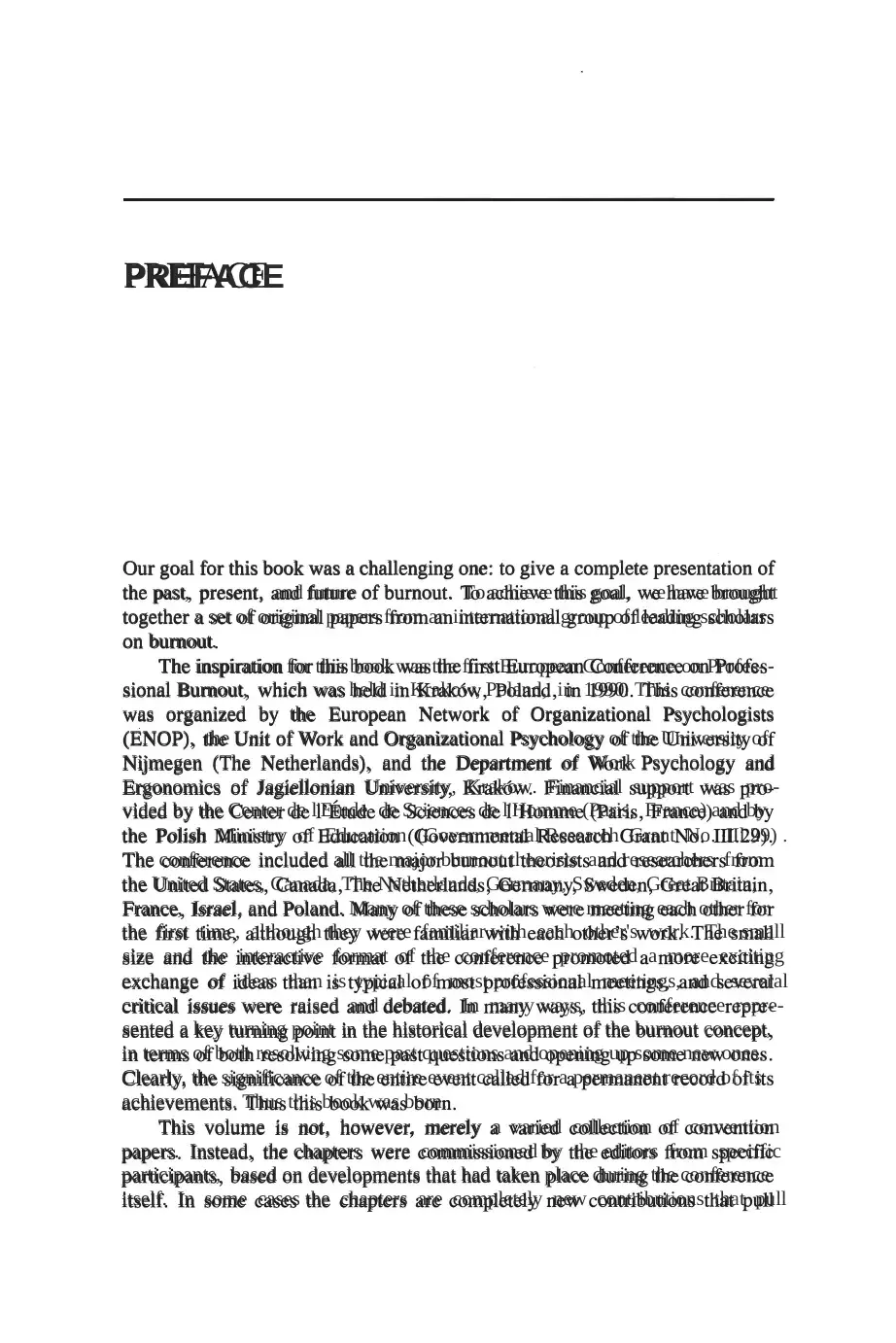
PREFACE
Our goal for this book was a challenging one: to give a complete presentation of
the past, present, and future of burnout. To achieve this goal, we have brought
together a set of original papers from an international group of leading scholars
on burnout.
The inspiration for this book was the first European Conference on Profes-
sional Burnout, which was held in Krakow, Poland, in 1990. This conference
was organized by the European Network of Organizational Psychologists
(ENOP), the Unit of Work and Organizational Psychology of the University of
Nijmegen (The Netherlands), and the Department of Work Psychology and
Ergonomics of Jagiellonian University, Krakow. Financial support was pro-
vided by the Center de l'Etude de Sciences de l'Homme (Paris, France) and by
the Polish Ministry of Education (Governmental Research Grant No. IIl.29) .
The conference included all the major burnout theorists and researchers from
the United States, Canada, The Netherlands, Germany, Sweden, Great Britain,
France, Israel, and Poland. Many of these scholars were meeting each other for
the first time, although they were familiar with each other's work. The small
size and the interactive format of the conference promoted a more exciting
exchange of ideas than is typical of most professional meetings, and several
critical issues were raised and debated. In many ways, this conference repre-
sented a key turning point in the historical development of the burnout concept,
in terms of both resolving some past questions and opening up some new ones.
Clearly, the significance of the entire event called for a permanent record of its
achievements. Thus this book was born.
This volume is not, however, merely a varied collection of convention
papers. Instead, the chapters were commissioned by the editors from specific
participants, based on developments that had taken place during the conference
itself. In some cases the chapters are completely new contributions that pull
Our goal for this book was a challenging one: to give a complete presentation of
the past, present, and future of burnout. To achieve this goal, we have brought
together a set of original papers from an international group of leading scholars
on burnout.
The inspiration for this book was the first European Conference on Profes-
sional Burnout, which was held in Krakow, Poland, in 1990. This conference
was organized by the European Network of Organizational Psychologists
(ENOP), the Unit of Work and Organizational Psychology of the University of
Nijmegen (The Netherlands), and the Department of Work Psychology and
Ergonomics of Jagiellonian University, Krakow. Financial support was pro-
vided by the Center de l'Etude de Sciences de l'Homme (Paris, France) and by
the Polish Ministry of Education (Governmental Research Grant No. IIl.29) .
The conference included all the major burnout theorists and researchers from
the United States, Canada, The Netherlands, Germany, Sweden, Great Britain,
France, Israel, and Poland. Many of these scholars were meeting each other for
the first time, although they were familiar with each other's work. The small
size and the interactive format of the conference promoted a more exciting
exchange of ideas than is typical of most professional meetings, and several
critical issues were raised and debated. In many ways, this conference repre-
sented a key turning point in the historical development of the burnout concept,
in terms of both resolving some past questions and opening up some new ones.
Clearly, the significance of the entire event called for a permanent record of its
achievements. Thus this book was born.
This volume is not, however, merely a varied collection of convention
papers. Instead, the chapters were commissioned by the editors from specific
participants, based on developments that had taken place during the conference
itself. In some cases the chapters are completely new contributions that pull
⊘ This is a preview!⊘
Do you want full access?
Subscribe today to unlock all pages.

Trusted by 1+ million students worldwide
1 out of 47
Your All-in-One AI-Powered Toolkit for Academic Success.
+13062052269
info@desklib.com
Available 24*7 on WhatsApp / Email
![[object Object]](/_next/static/media/star-bottom.7253800d.svg)
Unlock your academic potential
Copyright © 2020–2025 A2Z Services. All Rights Reserved. Developed and managed by ZUCOL.
